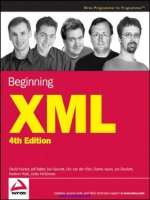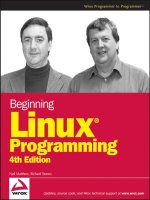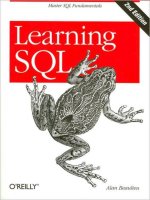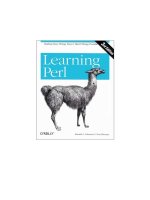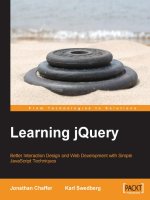learning jquery, 4th edition
Bạn đang xem bản rút gọn của tài liệu. Xem và tải ngay bản đầy đủ của tài liệu tại đây (6.55 MB, 444 trang )
www.it-ebooks.info
Learning jQuery
Fourth Edition
Better interaction, design, and web development with
simple JavaScript techniques
Jonathan Chaffer
Karl Swedberg
BIRMINGHAM - MUMBAI
www.it-ebooks.info
Learning jQuery
Fourth Edition
Copyright © 2013 Packt Publishing
All rights reserved. No part of this book may be reproduced, stored in a retrieval
system, or transmitted in any form or by any means, without the prior written
permission of the publisher, except in the case of brief quotations embedded in
critical articles or reviews.
Every effort has been made in the preparation of this book to ensure the accuracy
of the information presented. However, the information contained in this book is
sold without warranty, either express or implied. Neither the authors, nor Packt
Publishing, and its dealers and distributors will be held liable for any damages
caused or alleged to be caused directly or indirectly by this book.
Packt Publishing has endeavored to provide trademark information about all of the
companies and products mentioned in this book by the appropriate use of capitals.
However, Packt Publishing cannot guarantee the accuracy of this information.
First edition : July 2007
Second published: Feburary 2009
Third published: September 2011
Fourth published: June 2013
Production Reference: 1180613
Published by Packt Publishing Ltd.
Livery Place
35 Livery Street
Birmingham B3 2PB, UK.
ISBN 978-1-78216-314-5
www.packtpub.com
Cover Image by Karl Swedberg ()
www.it-ebooks.info
Credits
Authors
Jonathan Chaffer
Karl Swedberg
Reviewers
Kaiser Ahmed
Carlos Estebes
Alex Libby
Natalie MacLees
Acquisition Editor
Rukhsana Khambatta
Lead Technical Editor
Dayan Hyames
Technical Editors
Veena Pagare
Zafeer Rais
Kaustubh S. Mayekar
Project Coordinator
Leena Purkait
Proofreader
Paul Hindle
Indexer
Monica Ajmera Mehta
Graphics
Ronak Dhruv
Abhinash Sahu
Production Coordinator
Aditi Gajjar
Cover Work
Aditi Gajjar
www.it-ebooks.info
www.it-ebooks.info
Foreword
I feel honored knowing that Karl Swedberg and Jonathan Chaffer undertook the task
of writing Learning jQuery. As the rst book about jQuery, it set the standard that
other jQuery—and really, other JavaScript books in general—have tried to match. It's
consistently been one of the top-selling JavaScript books since its release, in no small
part due to its quality and attention to detail.
I'm especially pleased that it was Karl and Jonathan who wrote the book since I
already knew them so well and knew that they would be perfect for the job. Being
part of the core jQuery team, I've had the opportunity to come to know Karl quite
well over the past couple of years, and especially within the context of his book-
writing effort. Looking at the end result, it's clear that his skills as both a developer
and a former English teacher were perfectly designed for this singular task.
I've also had the opportunity to meet both of them in person, a rare occurrence in
the world of distributed open source projects, and they continue to be upstanding
members of the jQuery community.
The jQuery library is used by so many different people in the jQuery community.
The community is full of designers, developers, people who have experience in
programming, and those who don't. Even within the jQuery team, we have people
from all backgrounds providing their feedback on the direction of the project. There
is one thing that is common across all of jQuery's users: we are a community of
developers and designers who want JavaScript development to be made simple.
It's almost a cliché, at this point, to say that an open source project is community-
oriented, or that a project wants to focus on helping new users get started. But it's
not just an empty gesture for jQuery; it's the liquid-oxygen fuel for the project. We
actually have more people in the jQuery team dedicated to managing the jQuery
community, writing documentation, or writing plugins than actually maintaining the
core code base. While the health of the library is incredibly important, the community
surrounding that code is the difference between a oundering, mediocre project, and
one that will match and exceed your every need.
www.it-ebooks.info
How we run the project and how you use the code is fundamentally very different
from most open source projects—and most JavaScript libraries. The jQuery project
and community is incredibly knowledgeable; we understand what makes jQuery
a different programming experience and do our best to pass that knowledge on to
fellow users.
The jQuery community isn't something that you can read about to understand; it's
something that you actually have to participate in for it to fully sink in. I hope that
you'll have the opportunity to partake in it. Come join us in our forums, mailing
lists, and blogs and let us help guide through the experience of getting to
know jQuery better.
For me, jQuery is much more than a block of code. It's the sum of total experiences
that have transpired over the years in order to make the library happen. The
considerable ups and downs and the struggle of development together with the
excitement of seeing it grow and succeed. Growing close with its users and fellow
team members, understanding them and trying to grow and adapt.
When I rst saw this book talk about jQuery and discuss it like a unied tool, as
opposed to the experiences that it's come to encapsulate for me, I was taken aback
and excited. Seeing how others learn, understand, and mold jQuery to t them is
much of what makes the project so exhilarating.
I'm not the only one who enjoys jQuery on a level that is far different from a normal
tool-user relationship. I don't know if I can properly encapsulate why this is, but I've
seen it time and time again—the singular moment when a user's face lights up with
the realization of just how much jQuery will help them.
There is a specic moment where it just clicks for a jQuery user when they realize
that this tool that they were using was in fact much more than just a simple tool all
along—and suddenly their understanding of how to write dynamic web applications
completely shifts. It's an incredible thing and absolutely my favorite part of the
jQuery project.
I hope you'll have the opportunity to experience this sensation as well.
John Resig
Creator of jQuery
www.it-ebooks.info
About the Authors
Jonathan Chaffer is a member of Rapid Development Group, a web development
rm located in Grand Rapids, Michigan. His work there includes overseeing and
implementing projects in a wide variety of technologies, with an emphasis in PHP,
MySQL, and JavaScript. He also leads on-site training seminars on the jQuery
framework for web developers.
In the open source community, he has been very active in the Drupal CMS project,
which has adopted jQuery as its JavaScript framework of choice. He is the creator of
the Content Construction Kit, a popular module for managing structured content on
Drupal sites. He is also responsible for major overhauls of Drupal's menu system and
developer API reference.
He lives in Grand Rapids with his wife, Jennifer.
I would like to thank Jenny for her tireless enthusiasm and support,
Karl for the motivation to continue writing when the spirit is weak,
and the Ars Technica community for constant inspiration toward
technical excellence. In addition, I'd like to thank Mike Henry and
the Twisted Pixel team for producing consistently entertaining
distractions in between writing sessions.
www.it-ebooks.info
Karl Swedberg is a web developer at Fusionary Media in Grand Rapids, Michigan,
where he spends much of his time making cool things happen with JavaScript. As a
member of the jQuery team, he is responsible for maintaining the jQuery API site at
api.jquery.com. He is also a member of jQuery's Board of Advisors and a presenter
at workshops and conferences. When he isn't coding, he likes to hang out with his
family, roast coffee in his garage, and exercise at the local CrossFit gym.
I wish to thank my wife, Sara, and my two children, Benjamin and
Lucia, for all the joy that they bring into my life. Thanks also to
Jonathan Chaffer for his patience and his willingness to write this
book with me. Bryan, Steve, and Jack have supported me and given
me a paycheck for the past ve years, and for that I am truly grateful.
Many thanks to John Resig for creating the world's greatest
JavaScript library and to Dave Methvin and the core developer team
for taking up the torch.
www.it-ebooks.info
About the Reviewers
Alex Libby works in IT support. He has been involved in supporting end users
for the last 15 years in a variety of different environments and currently works
as a Technical Analyst supporting a medium-sized SharePoint estate for an
international parts distributor based in the U.K. Although Alex gets to play with
different technologies in his day job, his rst true love has always been with the
open source movement, and in particular experimenting with CSS3, HTML5, and
jQuery. To date, Alex has written several books for Packt Publishing, including one
on HTML5 Video and another on jQuery Tools.
Carlos Estebes is the founder of Ehxioz ( a Los
Angeles-based software development startup that specializes in developing
modern web applications and utilizing the latest web development technologies
and methodologies. He has over 10 years of web development experience and
holds a B.Sc. in Computer Science from California State University, Los Angeles.
He previously collaborated with Packt Publishing as a technical reviewer in the
third edition of Learning jQuery and jQuery Hotshot.
www.it-ebooks.info
Kaiser Ahmed is a professional web developer. He gained his B.Sc. from Khulna
University of Engineering and Technology (KUET) and M.Sc. in Computer Science
and Engineering from United International University, Dhaka. He is also a co-founder
of CyberXpress.Net Inc. (www.cyberxpress.net) based in Bangladesh.
He has been working as a Senior Software Developer at Krembo Interactive and
D1SH.COM CORP., Canada, for the last 2 years.
He has a wide breadth of technical skills, Internet knowledge, and experience across
the spectrum of online development in the service of building and improving online
properties for multiple clients. He enjoys creating site architecture and infrastructure,
backend development using open source toolsets (PHP, MySQL, Apache, Linux, and
others (that is, LAMP), frontend development with CSS and HTML/XHTML.
I want to thank my loving wife, Maria Akther, for her great support.
Natalie MacLees is a frontend web developer and UI designer, and is the
founder and principal of the interactive agency Purple Pen Productions. In 2012,
she published jQuery for Designers with Packt Publishing. She founded and runs the
jQuery LA Users' Group, and together with Noel Saw, she heads up the Southern
California WordPress User's Group, organizing WordPress meetups, help sessions,
and workshops. She makes her online home at nataliemac.com.
www.it-ebooks.info
www.PacktPub.com
Support les, eBooks, discount offers and more
You might want to visit www.PacktPub.com for support les and downloads related
to your book.
Did you know that Packt offers eBook versions of every book published, with PDF
and ePub les available? You can upgrade to the eBook version at
www.PacktPub.
com
and as a print book customer, you are entitled to a discount on the eBook copy.
Get in touch with us at for more details.
At
www.PacktPub.com, you can also read a collection of free technical articles, sign
up for a range of free newsletters and receive exclusive discounts and offers on Packt
books and eBooks.
TM
Do you need instant solutions to your IT questions? PacktLib is Packt's online
digital book library. Here, you can access, read and search across Packt's entire
library of books.
Why Subscribe?
• Fully searchable across every book published by Packt
• Copy and paste, print and bookmark content
• On demand and accessible via web browser
Free Access for Packt account holders
If you have an account with Packt at www.PacktPub.com, you can use this to access
PacktLib today and view nine entirely free books. Simply use your login credentials
for immediate access.
www.it-ebooks.info
www.it-ebooks.info
Table of Contents
Preface 1
Chapter 1: Getting Started 7
What jQuery does 8
Why jQuery works well 9
Making our rst jQuery-powered web page 11
Downloading jQuery 11
Deciding on the version of jQuery to use 12
Setting up jQuery in an HTML document 12
Adding our jQuery code 15
Finding the poem text 16
Injecting the new class 16
Executing the code 16
The nished product 18
Plain JavaScript versus jQuery 18
Using development tools 19
Chrome Developer Tools 20
Summary 23
Chapter 2: Selecting Elements 25
Understanding the DOM 25
Using the $() function 26
CSS selectors 28
Styling list-item levels 30
Attribute selectors 31
Styling links 32
Custom selectors 34
Styling alternate rows 35
Finding elements based on textual content 38
Form selectors 39
www.it-ebooks.info
Table of Contents
[ ii ]
DOM traversal methods 40
Styling specic cells 42
Chaining 44
Accessing DOM elements 45
Summary 46
Further reading 46
Exercises 47
Chapter 3: Handling Events 49
Performing tasks on page load 49
Timing of code execution 49
Handling multiple scripts on one page 51
Alternate syntax for .ready() 52
Passing an argument to the .ready() callback 52
Handling simple events 53
A simple style switcher 54
Enabling the other buttons 56
Making use of the event handler context 58
Consolidating code using the event context 60
Shorthand events 62
Showing and hiding advanced features 62
Event propagation 64
The journey of an event 65
Side effects of event bubbling 67
Altering the journey – the event object 67
Event targets 69
Stopping event propagation 69
Preventing default actions 70
Delegating events 71
Using built-in event-delegation capabilities 74
Removing an event handler 74
Giving namespaces to event handlers 75
Rebinding events 76
Simulating user interaction 78
Reacting to keyboard events 79
Summary 82
Further reading 82
Exercises 82
Chapter 4: Styling and Animating 85
Modifying CSS with inline properties 85
Setting computed style-property values 88
www.it-ebooks.info
Table of Contents
[ iii ]
Using vendor-specic style properties 91
Hiding and showing elements 91
Effects and duration 94
Speeding in 94
Fading in and fading out 95
Sliding up and sliding down 96
Toggling visibility 97
Creating custom animations 99
Building effects by hand 100
Animating multiple properties at once 101
Positioning with CSS 103
Simultaneous versus queued effects 105
Working with a single set of elements 105
Bypassing the queue 106
Queuing effects manually 107
Working with multiple sets of elements 109
Queuing with callbacks 111
In a nutshell 113
Summary 114
Further reading 114
Exercises 114
Chapter 5: Manipulating the DOM 115
Manipulating attributes and properties 115
Non-class attributes 116
Value callbacks 118
DOM element properties 120
The value of form controls 121
DOM tree manipulation 121
The $() function revisited 122
Creating new elements 122
Inserting new elements 123
Moving elements 124
Wrapping elements 126
Explicit iteration 127
Using inverted insertion methods 129
Copying elements 132
Cloning for pull quotes 133
Content getter and setter methods 136
DOM manipulation methods in a nutshell 138
Summary 139
Further reading 139
Exercises 140
www.it-ebooks.info
Table of Contents
[ iv ]
Chapter 6: Sending Data with Ajax 141
Loading data on demand 142
Appending HTML 143
Working with JavaScript objects 146
Retrieving JSON 147
Using global jQuery functions 148
Executing a script 152
Loading an XML document 153
Choosing a data format 156
Passing data to the server 158
Performing a GET request 158
Performing a POST request 162
Serializing a form 163
Delivering different content for Ajax requests 166
Keeping an eye on the request 167
Error handling 170
Ajax and events 172
Security limitations 173
Using JSONP for remote data 174
Exploring additional options 176
The low-level Ajax method 176
Modifying default options 177
Loading parts of an HTML page 177
Summary 180
Further reading 180
Exercises 180
Chapter 7: Using Plugins 181
Finding plugins and help 181
Using a plugin 182
Downloading and referencing the Cycle plugin 182
Calling a plugin method 183
Specifying plugin method parameters 184
Modifying parameter defaults 185
Other types of plugins 186
Custom selectors 186
Global function plugins 187
The jQuery UI plugin library 188
Effects 189
Color animations 189
Class animations 190
Advanced easing 191
www.it-ebooks.info
Table of Contents
[ v ]
Additional effects 191
Interaction components 192
Widgets 194
jQuery UI ThemeRoller 197
The jQuery Mobile plugin library 197
HTML5 custom data attributes 198
Mobile navigation 198
Delivering multiple pages in one document 204
Interactive elements 205
List views 206
Toolbar buttons 208
Advanced features 209
Summary 209
Exercises 210
Chapter 8: Developing Plugins 211
Using the dollar ($) alias in plugins 211
Adding new global functions 212
Adding multiple functions 215
Extending the global jQuery object 216
Isolating functions within namespaces 217
Adding jQuery object methods 218
Object method context 219
Implicit iteration 220
Enabling method chaining 221
Providing exible method parameters 222
The options object 223
Default parameter values 224
Callback functions 225
Customizable defaults 227
Creating plugins with the jQuery UI widget factory 229
Creating a widget 229
Destroying widgets 232
Enabling and disabling widgets 233
Accepting widget options 234
Adding submethods 235
Triggering widget events 236
Plugin design recommendations 237
Distributing a plugin 238
Summary 238
Exercises 239
www.it-ebooks.info
Table of Contents
[ vi ]
Chapter 9: Advanced Selectors and Traversing 241
Selecting and traversing revisited 242
Dynamic table ltering 243
Striping table rows 246
Combining ltering and striping 248
More selectors and traversal methods 249
Customizing and optimizing selectors 250
Writing a custom selector plugin 250
Selector performance 252
The Sizzle selector implementation 253
Testing selector speed 254
DOM traversal under the hood 256
jQuery object properties 256
The DOM element stack 258
Writing a DOM traversal method plugin 259
DOM traversal performance 261
Improving performance using chaining 261
Improving performance with caching 262
Summary 263
Further reading 263
Exercises 263
Chapter 10: Advanced Events 265
Revisiting events 265
Loading additional pages of data 267
Displaying data on hovering 269
Event delegation 271
Using jQuery's delegation capabilities 272
Choosing a delegation scope 272
Delegating early 273
Dening custom events 274
Innite scrolling 276
Custom event parameters 278
Throttling events 279
Other ways to perform throttling 280
Extending events 281
More about special events 284
Summary 285
Further reading 285
Exercises 285
www.it-ebooks.info
Table of Contents
[ vii ]
Chapter 11: Advanced Effects 287
Animation revisited 287
Observing and interrupting animations 290
Determining the animation state 290
Halting a running animation 291
Caution when halting animations 292
Using global effect properties 292
Disabling all effects 293
Dening effect durations 293
Multiproperty easing 296
Using deferred objects 297
Animation promises 298
Taking ne-grained control of animations 301
Summary 303
Further reading 303
Exercises 303
Chapter 12: Advanced DOM Manipulation 305
Sorting table rows 305
Sorting tables on the server 306
Sorting tables using Ajax 306
Sorting tables within the browser 307
Moving and inserting elements revisited 308
Adding links around existing text 309
Sorting simple JavaScript arrays 310
Sorting DOM elements 310
Storing data alongside DOM elements 312
Performing additional precomputation 313
Storing non-string data 314
Alternating sort directions 317
Using HTML5 custom data attributes 318
Sorting and building rows with JSON 321
Modifying the JSON object 323
Rebuilding content on demand 324
Revisiting attribute manipulation 325
Using shorthand element-creation syntax 326
DOM manipulation hooks 327
Writing a CSS hook 328
Summary 329
Further reading 330
Exercises 330
www.it-ebooks.info
Table of Contents
[ viii ]
Chapter 13: Advanced Ajax 331
Implementing progressive enhancement with Ajax 331
Harvesting JSONP data 334
Handling Ajax errors 337
Using the jqXHR object 339
Ajax promises 339
Caching responses 341
Throttling Ajax requests 342
Extending Ajax capabilities 343
Data type converters 344
Adding Ajax prelters 349
Dening alternate transports 350
Summary 353
Further reading 354
Exercises 354
Appendix A: JavaScript Closures 355
Creating inner functions 355
Calling inner functions from elsewhere 356
Understanding variable scope 358
Handling interactions between closures 360
Creating closures in jQuery 361
Passing arguments to $(document).ready() 362
Assigning event handlers 362
Binding handlers in loops 364
Giving names to functions 366
Handling memory-leak hazards 367
Avoiding accidental reference loops 368
Managing loops between the DOM and JavaScript 369
Disentangling reference loops with jQuery 370
Summary 371
Appendix B: Testing JavaScript with QUnit 373
Downloading QUnit 374
Setting up the document 374
Organizing tests 375
Adding and running tests 376
Asynchronous testing 379
Other types of tests 380
Practical considerations 380
Further reading 381
Summary 381
www.it-ebooks.info
Table of Contents
[ ix ]
Appendix C: Quick Reference 383
Selector expressions 383
Simple CSS 383
Position among siblings 384
Position among matched elements 384
Attributes 385
Forms 385
Miscellaneous selectors 386
DOM traversal methods 386
Filtering 387
Descendants 387
Siblings 387
Ancestors 388
Collection manipulation 389
Working with selected elements 389
Event methods 390
Binding 390
Shorthand binding 391
Triggering 392
Shorthand triggering 393
Utility 393
Effect methods 393
Predened effects 393
Custom animations 394
Queue manipulation 394
DOM manipulation methods 395
Attributes and properties 395
Content 396
CSS 396
Dimensions 397
Insertion 397
Replacement 398
Removal 398
Copying 399
Data 399
Ajax methods 399
Issuing requests 399
Request monitoring 400
Conguration 400
Utilities 401
www.it-ebooks.info
Table of Contents
[ x ]
Deferred objects 401
Object creation 401
Methods of deferred objects 401
Methods of promise objects 402
Miscellaneous properties and functions 403
Properties of the jQuery object 403
Arrays and objects 403
Object introspection 403
Other 404
Index 405
www.it-ebooks.info
Preface
In 2005, inspired by pioneers in the eld such as Dean Edwards and Simon Willison,
John Resig put together a set of functions to make it easy to programmatically nd
elements on a web page and assign behaviors to them. By the time he rst publicly
announced his project in January 2006, he had added DOM modication and basic
animations. He gave it the name jQuery to emphasize the central role of nding or
querying parts of a web page and acting on them with JavaScript. Rapidly over the
years since then, jQuery has grown in its feature set, improved in its performance,
and gained widespread adoption by many of the most popular sites on the Internet.
While Resig has since stepped down from his role as lead developer of the project,
jQuery has blossomed, in true open source fashion, to the point where it now boasts
a top-notch core team headed by Dave Methvin, as well as a vibrant community of
thousands of additional JavaScript developers.
The jQuery JavaScript library can enhance your websites regardless of your
background. It provides a wide range of features, an easy-to-learn syntax, and robust
cross-platform compatibility in a single compact le. What's more, hundreds of
plugins have been developed to extend jQuery's functionality, making it an essential
tool for nearly every client-side scripting occasion.
Learning jQuery Fourth Edition provides a gentle introduction to jQuery concepts,
allowing you to add interactions and animations to your pages—even if previous
attempts at writing JavaScript have left you bafed. This book guides you past the
pitfalls associated with Ajax, events, effects, and advanced JavaScript language
features, and provides you with a brief reference to the jQuery library to return to
again and again.
www.it-ebooks.info
Preface
[ 2 ]
What this book covers
Chapter 1, Getting Started, will get your feet wet with the jQuery JavaScript library.
The chapter begins with a description of jQuery and what it can do for you. It then
walks you through downloading and setting up the library, as well as writing your
rst script.
Chapter 2, Selecting Elements, will teach how to use jQuery's selector expressions and
DOM traversal methods to nd elements on the page, wherever they may be. You'll
use jQuery to apply styling to a diverse set of page elements, sometimes in a way
that pure CSS cannot.
Chapter 3, Handling Events, will walk you through jQuery's event-handling
mechanism to re off behaviors when browser events occur. You'll see how
jQuery makes it easy to attach events to elements unobtrusively, even before the
page nishes loading. Also, you'll get an overview of deeper topics, such as event
bubbling, delegation, and namespacing.
Chapter 4, Styling and Animating, will introduce you to jQuery's animation techniques
and how to hide, show, and move page elements with effects that are both useful
and pleasing to the eye.
Chapter 5, Manipulating the DOM, will teach you how to change your page on
command. This chapter will also teach you how to alter the very structure of an
HTML document, as well as adding to its content on the y.
Chapter 6, Sending Data with Ajax, will walk you through many ways in which
jQuery makes it easy to access server-side functionality without resorting to clunky
page refreshes. With the basic components of the library well in hand, you will be
ready to explore how the library can expand to t your needs.
Chapter 7, Using Plugins, will show you how to nd, install, and use plugins,
including the powerful jQuery UI and jQuery Mobile plugin libraries.
Chapter 8, Developing Plugins, will teach you how to take advantage of jQuery's
impressive extension capabilities to develop your own plugins from the ground up.
You'll create your own utility functions, add jQuery object methods, and discover the
jQuery UI widget factory. Next, you'll take a second tour through jQuery's building
blocks, learning more advanced techniques.
Chapter 9, Advanced Selectors and Traversing, will rene your knowledge of
selectors and traversals, gaining the ability to optimize selectors for performance,
manipulate the DOM element stack, and write plugins that expand selecting and
traversing capabilities.
www.it-ebooks.info



